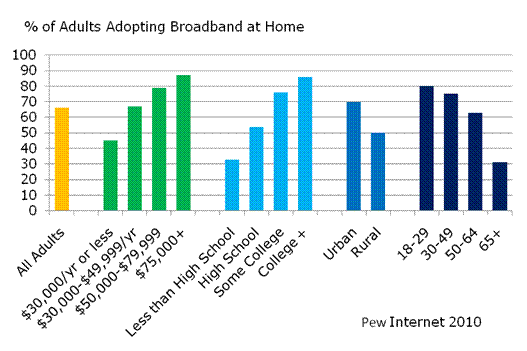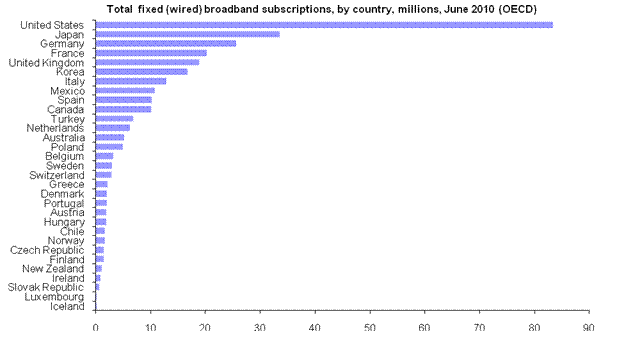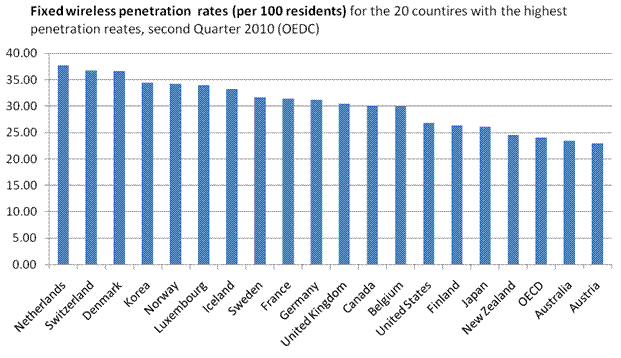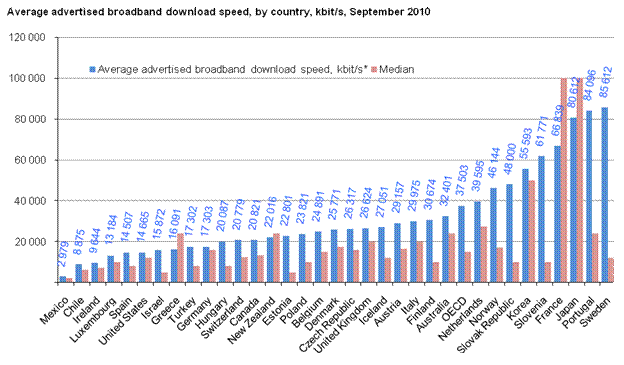What is broadband?
Broadband is a term you may be hearing a lot about lately. Broadband is shorthand for any type of high-speed Internet access. The FCC's definition of broadband is any system capable of transmitting data in excess of 1 Mbps upstream and 4 Mbps downstream. (FCC – Sixth Broadband Deployment Report, 2010) Communication systems that operate at a slower speed than broadband are called "narrowband." Usually consumers associate DSL and cable modems with broadband and dial-up services with narrowband.
Access to broadband opens up many possibilities such as voice services, high-speed data services, video services, and interactive information delivery services. These services can change how communities connect to each other, work, process information, and provide services.
Broadband technologies fall into two categories; wired and wireless. Wired technologies include cable, DSL, fiber and broadband over power line. Wireless technologies include fixed wireless, satellites, wi-fi and wi-max and Smart Phones.
Broadband in the USA
Broadband is such an essential part of the telecommunications infrastructure that the President considers it a national priority.
"Broadband can remove geographic barriers between patients and their doctors. It can connect our kids to the digital skills and 21st century education required for the jobs of the future. And it can prepare America to run on clean energy by helping us upgrade to a smarter, stronger, more secure electrical grid," President Obama, July 2, 2010
For most of urban centers and suburban communities, this goal has already been achieved. Unfortunately, broadband deployment in rural America lags behind the rest of the country. Accurate statistics on broadband availability in rural areas are sorely lacking, but there is no doubt that broadband options are more limited and more costly in many rural areas.
According to the Government Accounting Office (GAO) factors influencing broadband deployment include:
- the population in the area;
- the population density in the area;
- the percentage of the population residing in an urban area;
- the per capita income in the area;
- the educational attainment of the population in the area;
- the population teleworking in the area; the age of the population in the area;
- the distance to a metropolitan area with a population of 250,000 or more; and
- whether the state in which the area is located imposed a tax on Internet access in 2005.
Factors influencing broadband adoption include:
- the income of the household;
- the education attainment of the heads of the household;
- the age of the heads of the household;
- the presence of children in the household;
- the racial composition of the household;
- the occupation of the heads of the household;
- the number of people in the household;
- whether the household resides in an urban, suburban, or rural location;
- the number of companies providing broadband service in the area; and
- whether the state in which the household resides imposes a tax on Internet access.
The following chart demonstrates how many of these factors influence adoption of broadband by adults.

Communities need to make broadband access a priority for homes and businesses. The same GAO report found that strong leadership within a community can help promote broadband deployment by, for example, enhancing the likely market success of companies' entry into rural markets.
Other Considerations For Comparing Types of Delivery
Price vs. Speed
After determining what types of connections are available it can still be confusing to select a delivery method. Despite the confusing options, acronyms, technical terms, and statistics, the choice simply boils down to two criteria: price and speed. Generally speaking, faster connections correspond with higher bills. Before making any final decision about broadband options, it is important to consider how you or your organization will be using the Internet.
A Broadband Comparison of Download Speeds
| An email 5k |
Basic web page 25 k |
Complex web page 500 k |
Five minute song 5 Megs |
Movie preview 30 Megs |
Two-hour movie 500 Megs |
|
|---|---|---|---|---|---|---|
| Dialup | 1 sec. | 10 sec. | 90 sec. | 15 min. | 80 min. | 20 hrs. |
| ISDN | <1 sec. | 5 sec. | 40 sec. | 8 min. | 40 min. | 10 hrs. |
| Satellite | <1 sec. | <1 sec. | 15 sec. | 2 min. | 15 min. | 4 hrs. |
| DSL | <1 sec. | <1 sec. | 7 sec. | 1 min. | 7 min. | 2 hrs. |
| Cable | <1 sec.* | <1 sec.* | 4 sec.* | 40 sec.* | 4 min.* | 70 min.* |
| Wireless | <1 sec. | <1 sec. | 4 sec. | 40 sec. | 4 min. | 70 min. |
A Broadband Comparison of Download Speeds
| Average price Per megabit/second | Monthly price for 256 kbps-1.9 Mbps | Average monthly price for 2 - 11.9 Mbps | Average monthly price for 12 - 32 Mbps | Average monthly price for > 35 Mbps | |
|---|---|---|---|---|---|
| United States | $8.06 | $23.74 | $36.90 | $60.13 | $122.45 |
| ODCC Average | $8.75 | $30.23 | $41.94 | $67.43 | $72.85 |
Source: GAO analysis of OECD data
How Fast is Your Connection?
Are you getting the speed that you are paying your Internet Service Provider for? Test your connection by going to The Global Broadband Speed Test and click on the pyramid that is geographically the closest to see your current download speed. Note the speed, then close the window to return here when you are done.
You will likely find wide variations in your estimated speed, depending on network traffic, locations of servers and other factors. In general, if your speed is 85% of the rated speed for the connection you have paid for, you are in good shape. Which of the following is the best fit for your speed test findings?
Symmetry
When thinking about delivery methods for Internet it is important to think about available speeds for downloading and uploading. Most services are asymmetrical meaning they offer faster download speeds than upload speeds. This model made sense when most users were heavy downloaders. Those patterns are changing and many users and businesses are demanding higher upload speeds.
How Does the U.S. Compare?
From the previous section you saw several comparisons of broadband in terms of price and speed. It is important to realize that definitions of what constitutes broadband differ around the world. In general people in the United States pay more for slower speeds. The following information from the Organization for Economic Co-operation and Development (OEDC), an international organization that promotes policies that will improve the economic and social well-being of people around the world, provides a basis for understanding how the United States broadband services and adoption compares to other countries.
The chart below from the OECD is shows the number of fixed broadband subscriptions for a number of countries as of June 2010.

Fixed broadband connections can be delivered over wires or wirelessly. The following chart provides a look at how fixed broadband is delivered in several countries. Cable and DSL are used to deliver broadband to the majority of homes and businesses in the U.S.

The chart below shows that the United States ranks 14th in broadband penetration, a huge decline from being 4th in 2000. This speaks to the importance of federal policies.

The following chart from the OEDC data shows that different countries have different expectations for broadband. The chart shows the average advertized and median broadband download speeds for these countries. Japan offers the most third highest advertised download speed (80 Mbps). The United States is lagging not only in broadband penetration but also in available speeds. In order for the United States to compete in a global economy availability as well as price and speed need to be considered by top policy makers.

The ITU also pointed out that countries that lowered their prices also have higher broadband penetration. The United States could learn from this example and seek to increase broadband availability by offering increased speeds and decreased costs.
Broadband - Expectations Differ
As you can see from these discussions, all broadband is not equal. Not only do we have issues of unequal access within the United States but when considered from a global perspective we can see more inconsistencies. Despite the technology used to deliver service it is clear that different countries define broadband differently.
